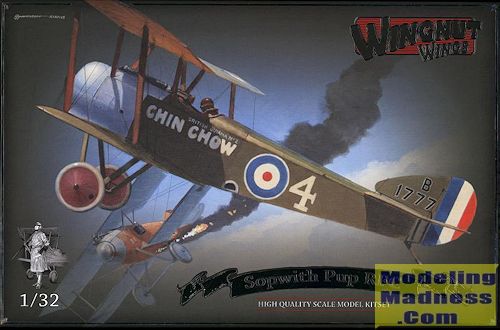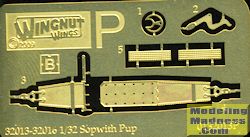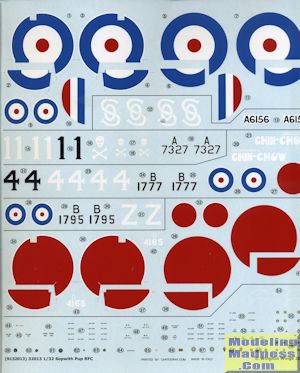
Wingnut Wings 1/32 Sopwith Pup
| KIT #: | 32013 |
| PRICE: | $69.95 SRP |
| DECALS: | Five options |
| REVIEWER: | Scott Van Aken |
| NOTES: | 2009 boxing |

| HISTORY |
| THE KIT |
 The LHS got in some WNW kits and though I at one time owned the first kit they did, sold it off, knowing I would not build it. Not so this one. Several friends recommended this one to me as being a fairly easy build without a ton of teeny parts and basic rigging. As I'm afflicted with rigaphobia, this seemed like something I could handle.
The LHS got in some WNW kits and though I at one time owned the first kit they did, sold it off, knowing I would not build it. Not so this one. Several friends recommended this one to me as being a fairly easy build without a ton of teeny parts and basic rigging. As I'm afflicted with rigaphobia, this seemed like something I could handle.
If you have never seen a WNW kit, and are interested in large scale WWI aircraft, then you should seriously consider getting one. These folks have done their research both in terms of the subject and in providing exactly what is needed by the modeler to produce a quality scale replica.
The molding is top notch and while, like most everything these days, is pressed in China, the kit is free of any sort of molding glitches. There are a few ejector pin marks inside a few parts, like fuselage halves, but they are so engineered as to be invisible once the kit has been completed and they are quite shallow. Each of the five plastic sprues is individually wrapped to prevent issues from scuffs or from sprues getting interlocked. The sprue gates are properly small and do not intrude on the part itself.
 The photo etch fret is small and appropriate with the parts consisting of a lap belt, the trigger and forward frame on the machine gun and two small reinforcement plates for the inside of the lower wing. One clear sprue is provided that give you several windscreens and some pulley inspection panels for the wing.
The photo etch fret is small and appropriate with the parts consisting of a lap belt, the trigger and forward frame on the machine gun and two small reinforcement plates for the inside of the lower wing. One clear sprue is provided that give you several windscreens and some pulley inspection panels for the wing.
As simple as the Pup may be, you are provided with a number of options, depending on the markings that you will be using. You get two different cowlings, two different props, and the ability to model the fixed and adjustable tailplane. All of the control surfaces are separate allowing you to pose them in something other than the static position. A nicely done instrument panel is part of the kit with separate instrument decals.
 One of the highlights of the kit is the instruction booklet. This is beautifully printed and illustrated with lots of color as well as photos, both current and period, of various parts of the aircraft. A complete internal rigging diagram is included so you can properly rig the rudder pedals and the control stick. All of the external rigging is shown as well, and this incorporates period photos of the flight control surfaces so you can see how the control cables attach. Engine wiring diagrams as well as overall and detail photos of an extant engine are included to help with detailing this part of the model.
One of the highlights of the kit is the instruction booklet. This is beautifully printed and illustrated with lots of color as well as photos, both current and period, of various parts of the aircraft. A complete internal rigging diagram is included so you can properly rig the rudder pedals and the control stick. All of the external rigging is shown as well, and this incorporates period photos of the flight control surfaces so you can see how the control cables attach. Engine wiring diagrams as well as overall and detail photos of an extant engine are included to help with detailing this part of the model.
Markings are provided for five aircraft, all in the standard scheme of the day of PC10 with linen lower wing undersides and metal forward fuselage. For the RFC there are four options with one from 54 Squadron and the other three from 46 Squadron. There is also a postwar unarmed Japanese plane from 1921. The large decal sheet is superbly printed and provides all the markings that are needed.
| CONCLUSIONS |
If I've not already left the impression that this is a world class kit, then allow me to state that this is a world class kit. It provides all you need save rigging material and paint. While I'm not sure if this one would be considered 'rigging light', single bay biplanes are usually easier to rig than more complex types. When I finally get up the nerve to tackle something like this, this will be the kit I will build.
| REFERENCES |
http://en.wikipedia.org/wiki/Sopwith_Pup
April 2015
If you would like your product reviewed fairly and fairly quickly, please contact the editor or see other details in the